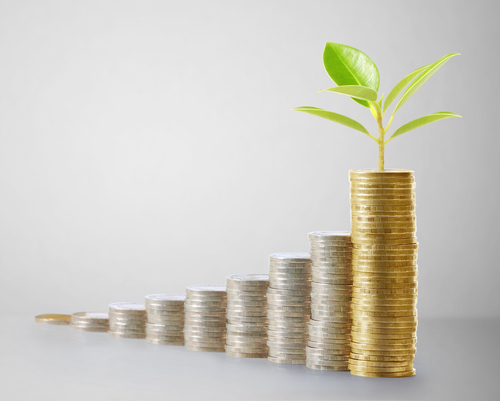Some investors prefer a conservative approach to investing in securities, choosing dividend-paying stocks with lower volatility. Others prefer high-risk, high-reward investments from growth stocks. Investors looking to hedge their investments play somewhere in-between, relying on dividend growth investing.
This Dividend Investing strategy involves buying stocks that have a track record of dividend growth that’s expected to continue. Holding the stock long-term lets investors reap the benefits of a compounding. Dividends can be reinvested to generate more income over time.
Not Every Dividend-Payer is a Dividend Growth Stock
Just because a company pays a dividend doesn’t make it a candidate for a dividend growth investing strategy. Dividend growth is about focusing on dividends that will appreciate over time. But as many investors already know, the presence of a dividend is anything but certain. Dividends can go stagnant, be cut or go away altogether.
Our income expert, Marc Lichtenfeld, researches hundreds of the top dividend stocks to determine their safety. You can find his most recent research here: Dividend Safety Net.
Picking dividend growth stocks means looking for companies with an established track record of not only paying their dividends, but raising them as well. Thankfully, there’s already an easy way to find these companies: Just look for Dividend Aristocrats. These are companies that have increased their dividend for 25 consecutive years or more.
Now, it’s possible for a company to be a dividend growth stock without being a Dividend Aristocrat—they might not have 25 consecutive years of dividend increases. This list isn’t inclusive of all dividend growth stocks and excludes some of the best up-and-coming companies that may not yet be 25 years in the public markets.
If a company has increased its dividend while maintaining a healthy balance sheet, it’s likely a good candidate for dividend growth investing. But if it offers a dividend that’s been previously cut, tread lightly.
Not All Dividend Growth Stocks are the Same
Just like not all dividend-paying stocks are growth stocks, not all growth stocks are the same. There are a few important distinctions to pay attention to when picking one stock over another.
First, is the rate of dividend growth. Every company that increases its dividend will do so at a different rate depending on certain factors (see below). This means not all dividend growth stocks will offer the same rate of return to shareholders. For example, two companies may both be valued at $40 per share, with the same dividend of $0.80 per share. However, Company A chooses to raise its dividend by $0.20 while Company B increases its by $0.05. Both companies are growing their dividend, but Company A is doing so at a more attractive rate.
It’s also critical to look at is the history of dividend increases by a company. If Company A has a track record of raising its dividend every five years, but Company B raises its dividend like clockwork every year, the value of this growth requires closer inspection. In the example above, Company B may actually be the more attractive stock. It’s dividend growth will amount to $0.25 per share over 5 years, as opposed to Company A’s $0.20 in the same time.
When choosing between dividend growth stocks, every investor needs to look at both the value of the dividend and the rate at which it grows. These two factors can help distinguish your options.
The Dangers of Dividend Growth Investing
As with any investment, there are some drawbacks to investing in U.S. dividend growth stocks. Specifically, major cuts to a dividend or the complete loss of one can invalidate your entire investing strategy.
Take a look at an example like General Electric (NYSE: GE). GE was one of the 12 original stocks to comprise the Dow Jones Industrial Index and a dividend-paying stock for 120 years. For decades GE’s dividend grew… until just a few years ago. GE slashed its dividend in half virtually overnight, then down to just $0.01 in late 2018.
GE is an extreme example to be sure, but a cautionary tale for dividend growth investors. It’s important to look at how a company is run, the health of the balance sheet and market factors that may jeopardize a dividend, no matter how much momentum it has behind it.
Growth Factors to Consider
Past trends may be indicative of future ones, but nothing is certain. In addition to looking at a company’s track record of dividend growth and payouts, it’s important to look at their current balance sheet and future financial position. Investors can learn a lot about how a company may handle their dividend in the future based on their finances today. Here are a few simple figures to observe and what they mean:
- The Price/Earnings to Growth and Dividend Yield (PEGY Ratio) is a good indicator of the health of a dividend-paying stock—especially for larger companies.
- The Payout Ratio shows the portion of income paid out as dividends. If the payout ratio is too high, it could represent an upcoming dividend cut.
- Taking a look at the Debt-to-Equity Ratio of a company can clue investors in on a company with mounting debt. A company may cut the dividend to pay back debt.
- Looking at Free Cash Flow will determine if a company has adequate funds to continue paying out its dividend without straining its balance sheet.
These are just some of the general metrics to observe when evaluating potential dividend growth stocks. There are also various dividend discount models and additional metrics for calculating the health of a dividend-paying stock.
Dividend growth investing is a smart way to invest in stocks. Stick to investing in companies with a track record of sustainable growth. It’s a strategy based on stability, and what investor doesn’t love stability?
Good investing,
Rob Otman
